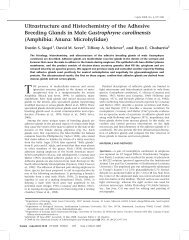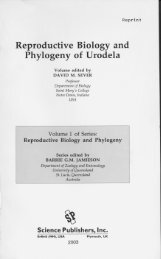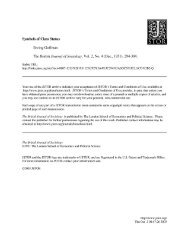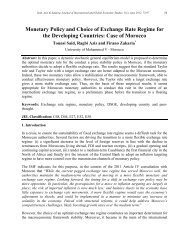Marvelous Facts and Miraculous Evidence in Early Modern Europe ...
Marvelous Facts and Miraculous Evidence in Early Modern Europe ...
Marvelous Facts and Miraculous Evidence in Early Modern Europe ...
You also want an ePaper? Increase the reach of your titles
YUMPU automatically turns print PDFs into web optimized ePapers that Google loves.
118 Lorra<strong>in</strong>e Daston<br />
<strong>Facts</strong> <strong>and</strong> <strong>Evidence</strong><br />
Glanvill warned that witches <strong>and</strong> evil spirits could simulate miracles with<br />
"wonderful Comb<strong>in</strong>ations of natural Causes" (ST, p. 52). But already <strong>in</strong> the<br />
1660s the devil had yielded the title of Great Deceiver to enthusiasts, both<br />
s<strong>in</strong>cere <strong>and</strong> feigned. Long before Shaftesbury called on a witness <strong>in</strong> favor<br />
of a "new Prophesy<strong>in</strong>g Sect" <strong>and</strong> its purported miracles to prove himself<br />
"wholly free of melancholy, <strong>and</strong> ... <strong>in</strong>capable of all Enthusiasm besides,"78<br />
portents <strong>and</strong> miracles had become associated among the learned with "all<br />
the common causes of deceit, Superstition, Melancholy, natural weakness of<br />
sight, softness of imag<strong>in</strong>ation" <strong>and</strong> other flaws of body <strong>and</strong> soul (DCP, p.<br />
183). Tojudge from Clarke's 1705 Boyle lectures, even Christ was <strong>in</strong> some<br />
circles suspected of baneful enthusiasm (see D, p. 373).<br />
The deep-seated anxiety about imposture, both diabolical <strong>and</strong><br />
human, was simply the obverse of the emphasis on miracles as evidence.<br />
For the evidentiary theologians, the truth of Christian revelation was<br />
chiefly supported "by the many <strong>in</strong>fallible Signs <strong>and</strong> Miracles, which the<br />
Author of it worked publickly as the <strong>Evidence</strong> of his Div<strong>in</strong>e Commission"<br />
(D, p. 372).79 Miracles were God's signature, "the greatest testimony of<br />
Div<strong>in</strong>e authority <strong>and</strong> revelation" (OS, p. 139). However, <strong>in</strong> contrast to most<br />
testimonial evidence, what must be proved is not the trustworth<strong>in</strong>ess but<br />
rather the identity of the witness, for once God's identity was established,<br />
absolute trustworth<strong>in</strong>ess followed necessarily for seventeenth-century the-<br />
ologians.80 S<strong>in</strong>ce belief <strong>in</strong> revelation <strong>and</strong>, conversely, rejection of heresy<br />
was <strong>in</strong> their view the gravest of human duties, no pa<strong>in</strong> should be spared <strong>in</strong><br />
dist<strong>in</strong>guish<strong>in</strong>g div<strong>in</strong>e signatures from forgeries. Fleetwood went so far as<br />
to make the miracle itself subsidiary to the signature, advis<strong>in</strong>g his readers<br />
that "you are under no obligation of Necessity, to believe all that a Man<br />
shall say, who works Miracles, without declar<strong>in</strong>g he is sent of God, <strong>and</strong> tell<strong>in</strong>g<br />
you, that God has given him that miraculous Power, <strong>in</strong> order to obta<strong>in</strong><br />
Credit with you" (EM, p. 117). Confident that God always provides "sufficient<br />
marks" for the "impartial Enquirers after Truth" to dist<strong>in</strong>guish true<br />
from false miracles (WJT, 2:499), the theologians sought the signs that<br />
would validate the "Signs <strong>and</strong> Wonders." The claim that miracles were<br />
irrefutable evidence thus led willy-nilly to the dem<strong>and</strong> for still further evidence<br />
that the miracles <strong>in</strong> question were genu<strong>in</strong>e.<br />
The cl<strong>in</strong>ch<strong>in</strong>g evidence for the authenticity of an ambiguous miracle<br />
was doctr<strong>in</strong>al. As we have seen, both the objective criterion of supernatural<br />
causation <strong>and</strong> the subjective criterion of wonder dissolved under the<br />
scrut<strong>in</strong>y of seventeenth-century theologians: too little was known of<br />
nature to locate the boundary between natural <strong>and</strong> supernatural causes,<br />
78. [Shaftesbury], A Letter Concern<strong>in</strong>g Enthusiasm, to My Lord ***** (London, 1708),<br />
pp. 68-69.<br />
79. See also WJT, 2:498, <strong>and</strong> OS, pp. 138-39.<br />
80. Sometimes, however, theologians enterta<strong>in</strong>ed the possibility that God might allow<br />
false prophecies to be fulfilled to "try the People's Faith <strong>and</strong> Constancy" (EM, p. 57).







